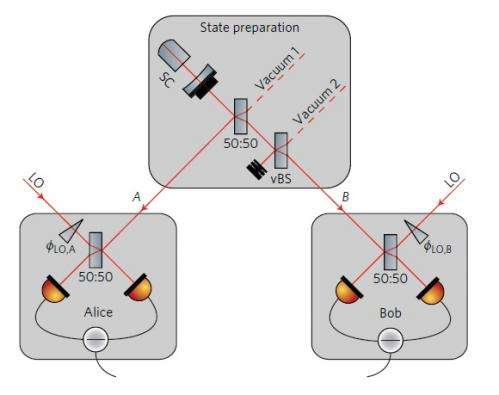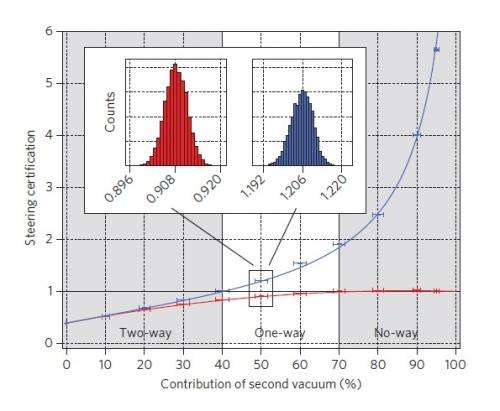September 17, 2012 feature
Â鶹ÒùÔºicists experimentally demonstrate one-way quantum steering

(Â鶹ÒùÔº)—When Einstein described the interaction between two distant objects as "spooky interaction at a distance," he was referring to the quantum phenomenon called steering. Steering can occur in strongly entangled systems and implies a direction between the two parties involved, while entanglement without steering generally has no direction. In 1992, physicists experimentally demonstrated steering in both directions – that is, both parties could steer each other. Now for the first time, physicists have demonstrated steering in one direction only, a feat that gives new insight into the quantum world and that could have applications in quantum information.
The physicists, from the University of Hannover's Center for Quantum Engineering and Space-Time Research-QUEST, the Max Planck Institute for Gravitational Â鶹ÒùÔºics (Albert Einstein Institute), and the Institute for Theoretical Â鶹ÒùÔºics, all in Hannover, Germany, have published their study in a recent issue of Nature Photonics.
As the scientists explain, steering forms the core of the famous Einstein-Podolosky-Rosen (EPR) argument put forth in 1935. As an attempt to criticize quantum mechanics, the three scientists theoretically pointed out an odd effect of two strongly correlated particles: measuring a quantity (such as the position or the momentum) of particle A will cause the related quantity of particle B to become certain, even though the Heisenberg Uncertainty Relation predicts a minimum quantum uncertainty for individual systems. This odd effect exists even if the particles do not come in contact with each other. To explain this finding, Einstein, Podolosky, and Rosen assumed that the outcome of all possible measurements must be encoded in both particles as a hidden parameter, and that quantum mechanics is incomplete because it does not account for this parameter. Otherwise, the instantaneous interaction would conflict with the theory of relativity.
However, other physicists of the day saw that the interaction was actually a new quantum phenomenon. Erwin Schrödinger was the first to call the effect "entanglement" as well as describe its stronger form, steering. In steering, the two parties (Alice and Bob) have certain roles that are not interchangeable. Specifically, Alice has the role of choosing an observable to be measured, which somehow changes the states in Bob's system. If Bob chooses the observable to be measured, then the roles would change, and he would be the one steering Alice.
Because of the two different roles, physicists have wondered about the possibility of one-way steering. That is, are there any physical states that Alice could send that allow her to steer Bob, but not vice versa?

To demonstrate that the answer is yes, the physicists here entangled two laser beams that they prepared using an intricate system that involved mixing the beams with two vacuum modes. One output mode was sent to Alice and one to Bob. If the beams were prepared with the vacuum contribution in a certain intermediate range, the researchers observed that Alice could make a measurement on her side that influenced Bob's measurements on his side – but Bob's measurements did not influence Alice's. In other words, they observed one-way steering.
However, changing the vacuum contribution could change the results. The researchers found that, for a vacuum contribution smaller than 39%, two-way steering was allowed. And for a vacuum contribution greater than 70%, no steering was allowed. In between these values, only Alice could steer.
"From the very beginning in 1935, EPR and Schrödinger focused on the question of whether a single subsystem (of an entangled state) can be described by a classical model, given some measurement results on the other subsystem," coauthor Roman Schnabel of the University of Hannover and the Max Planck Institute for Gravitational Â鶹ÒùÔºics told Â鶹ÒùÔº. "In our paper, we produce for the first time an entangled state that allows for a purely classical description of one subsystem but not of the other. Our result supports the relevance of the original question by EPR and Schrödinger since we demonstrate that the answer is more diverse than one might expect."
As he explained further, the results also provide insight into the extent to which quantum mechanics differs from classical mechanics, one of the fundamental questions in physics.
"Our experiment pinpoints the effect of decoherence," he said. "Our state is produced by discarding information from one subsystem (due to the extra vacuum contribution). The one-sided information loss results in the new situation that this subsystem can be described by a classical model whereas the other subsystem still requires a quantum model. There is a long debate on how the transition from a distinct (entangled) quantum system to a system that can be described by a classical model actually happens. Our experiment is thus a nice model system that shows how decoherence produces the transition from the quantum to the classical world."
The researchers expect that the experiment can be extended to a tripartite situation involving a third party, Charlie. In the current experiment, one output mode of the light beam was dumped, but if it had been sent to Charlie, the researchers predict that Alice could also steer Charlie simultaneously to steering Bob. Neither Bob nor Charlie could steer anyone.
As the physicists explain, one-way steering is yet another counterintuitive effect of quantum mechanics. They explain that one-way steering leads to the peculiar situation in which two experimenters performing measurements on the same shared state reach different conclusions. Future research into this implication and others could have applications in areas such as quantum key distribution for secure communication and information science in general.
More information: Vitus Händchen, et al. "Observation of one-way Einstein-Podolsky-Rosen steering." Nature Photonics.
Journal information: Nature Photonics
Copyright 2012 Â鶹ÒùÔº
All rights reserved. This material may not be published, broadcast, rewritten or redistributed in whole or part without the express written permission of Â鶹ÒùÔºOrg.com.

















